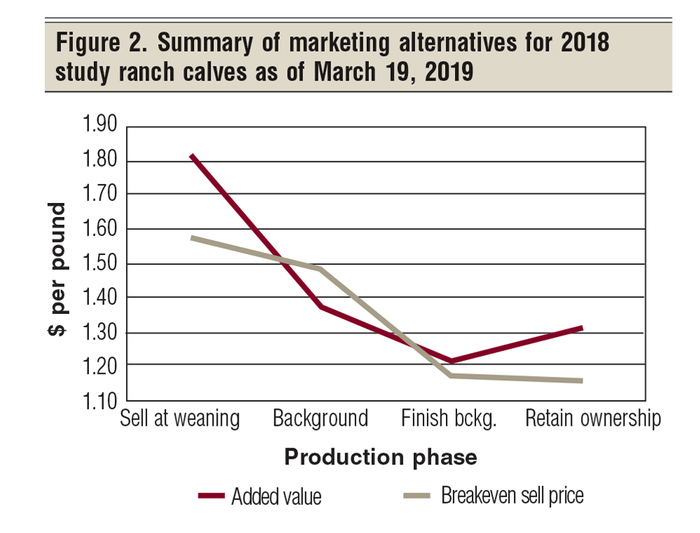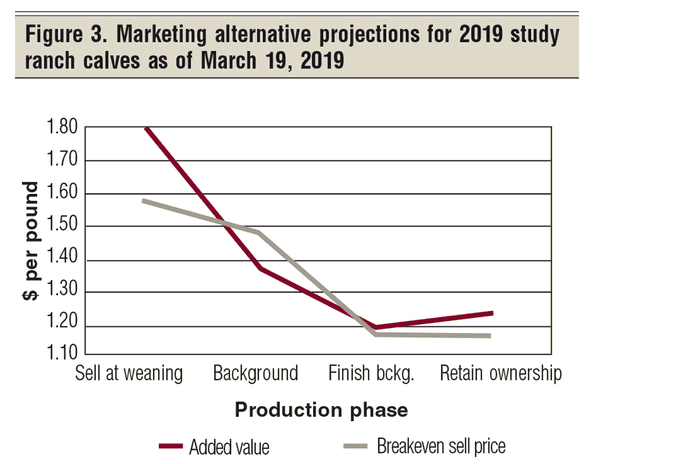Year 2019 is a year to focus on costs of production.
May 6, 2019

Each year, my study rancher asks how he should market that year’s calf crop, and he recently asked again relating to his 2019 calves. I will share my current response to this marketing question here.
While he has already marketed his 2018 calves at weaning, I routinely share with this rancher the monthly market analysis that I do for his beef cow operation. I want him to be thinking continually about how he should be marketing the calves from his beef cow herd.
First, I will look at the marketing alternative analysis for his 2018 calves. Then we will apply this same analysis to his potential 2019 calves, which will be hitting the ground soon.
I find it most useful to first build a table of the marketing alternatives that a rancher is willing to consider. This table lists the potential marketing weights, marketing dates and my latest projected marketing prices for each marketing alternative. These tables generate a lot of discussion whenever we get together.
Figure 1 presents the most current table I generated for my study rancher’s beef cow herd with respect to his 2018 calves. Two of these marketing programs — selling at weaning and backgrounding the calves — are already history. Two of the programs — finishing the backgrounded calves and retaining ownership of his 2018 calves — are still to be completed in 2019.

Selling at weaning. My study rancher’s 2018 steer calves averaged 577 pounds at weaning and sold for $181 per cwt in mid-October 2018. His calculated cost of gain for selling a pound of steer calf in 2018 was $1.57 per pound, or $157 per cwt of steer calf produced.
Thus, we calculated that he netted $24 per cwt of steer calf marketed in 2018, compared to the net $47 per cwt of steer calf marketed in 2017. We are currently projecting he will net $22 per cwt of steer calf marketed in 2019.
This is the expected trend, given where we are in the current beef price cycle. Yes, my study rancher realizes that he has to really focus on his beef cow herd’s production costs in 2019!
Backgrounding. My projections for backgrounding this rancher’s 2018 calves up to 875 pounds, with a marketing date of Feb. 20, 2019, generated a market price of $138 per cwt. Cost of gain on these calves was projected at 84 cents per pound of gain.
After adjusting for the initial cost of the weaned steer calves transferred into the backgrounding enterprise, the breakeven sale price was $1.48 per pound. Given my February 2019 market price documented at $1.38, this projects a loss of 10 cents per pound for every pound of gain in these backgrounded 2018 calves.
Finishing the backgrounded calves. Finishing these backgrounded calves in a commercial feedlot with a target marketing date of June 14, 2019, is projected to have a total cost of 75 cents per pound of gain.
After adjusting for the initial value of the feeders going into the commercial feedlot, the final breakeven sale price was projected at $1.17 per pound.
With the value of added weight (market price) at $1.22 per pound, a profit of 5 cents per pound of gain is projected. This small projected finishing profit, however, did not offset the rancher’s projected backgrounding loss.
Retained ownership. In this marketing option, we take the weaned calves and move them to a commercial feedlot to grow and finish the animals. It is assumed that the commercial lot will grow and finish these calves with a marketing date of May 11, 2019. Generally, finished cattle prices are higher in May than in June (assumed in the previous marketing option); and indeed, that is the current projection for 2019.
The final value of these feeders is projected at $1.31 per pound, with a breakeven sale price of $1.16 per cwt, after adjusting for the value of the weaned calf going into the lot and the 65-cent-per-pound cost of gain. This generates a projected $188 profit per head! Yes, finishing cattle in May 2019 is projected to make a profit. The exception might be feedlots that experienced the HUGE snow storms during this last winter.
Figure 2 is a summary chart that I like to use in evaluating these four marketing alternatives. Note that the maroon line represents the added value per pound in dollars per pound for each marketing option. The tan line represents the breakeven market price in dollars per pound needed to break even for each marketing option.

The tan line numbers integrate the cost of gain for the added weight put on, plus the dollar adjustment needed for the initial market value of the animal transferred into each marketing option. I use this method of evaluating market alternatives because I suspect some ranchers do not put an initial price on their weaned calves going into their own feeder program — especially in a rancher-run backgrounding program.
When a rancher tells me how much money he’s going to make backgrounding calves, I always ask, “Did you price in the initial market value of the weaned calves?”
Quite often, the answer is no. If the answer is no, I then ask, “Are you going to make your money preweaning or postweaning?” To answer this question, he has to price his calves at weaning.
Marketing 2019 calves. Now that you understand how Figure 2 was generated, let’s look at Figure 3, the same chart with marketing projections for 2019 calves.
Figure 3 projects the profit per pound produced for these same four marketing alternatives for my study rancher with his 2019 spring-born calves. The two marketing alternatives that are projected to make a profit are selling at weaning and retained ownership.

My study rancher wants to monitor this chart monthly as we move through 2019. His first marketing decision will be made in October 2019 around weaning time.
A final note. The economic impact of the cattle cycle surfaces in Figure 4. A study of the profit projections by marketing program over the years 2017, 2018 and 2019 reflects the challenge of where we are in the current beef price cycle.
Note that each marketing option tends to go down as we move from year 2017 to current 2019 projections. Let’s hope 2019 is the bottom of the current beef price cycle.
Year 2019 is a year to focus on costs of production!
Hughes is a North Dakota State University professor emeritus. He lives in Kuna, Idaho. Reach him at 701-238-9607 or [email protected].
About the Author(s)
You May Also Like





